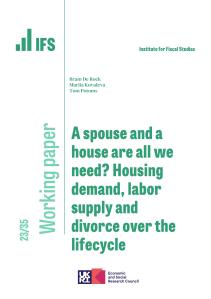If there’s one thing that everyone in politics seems to agree on, it’s that we need to solve the housing crisis. There’s even a degree of accord about the cause of the problem and therefore the solution: we haven’t been building enough houses and we need to build an awful lot more. Which is odd. It’s odd in the first place because there’s not even agreement on what the housing crisis actually is. Secondly, it’s odd because most of the available evidence suggests that plausible amounts of additional housebuilding would do little to solve the crisis, whatever it is.
The sharp end is homelessness. About 5,000 people sleep on England’s streets on any one night, almost three times as many as were sleeping rough in 2010. Another 80,000 families live in temporary accommodation. Around 60,000 of these are families with children. Again, the numbers have increased over the past decade, by about 60 per cent.
All these families are in crisis. They have been driven into homelessness by some combination of health problems, family breakdown, the benefits system, loss of work, high rents, inadequate social services and a lack of permanent social housing. However, with well over 200,000 homes added to the housing stock of about 25 million last year, it’s pretty obvious that simply building more can’t be the main solution to this particular crisis. We know from the experience of the Blair-era rough sleepers unit that the causes and solutions are much more complex — but also are tractable with focus and resources.
The wider issue is one of affordability. For younger people, housing costs have risen much faster than incomes over the past 20 years, mostly because so many more of them are now renting privately rather than buying with a mortgage or renting from the council. This shift into relatively expensive private rented accommodation has also driven rises in work poverty.
The flipside has been a dramatic fall in home ownership rates among twenty and thirtysomethings. As house prices have doubled relative to average earnings, home ownership rates among young people on middle incomes have more than halved. Prices have gone up. Simple economics would suggest that supply and demand have got out of kilter. So we need to increase the supply of housing in order to bring prices down. Hence the obvious answer must be to build more houses.
Wait a minute, though. The cost of owner occupation is not just the price of the house. It depends on the interest rate. And interest rates have come down and down in the past 30 years. In a paper published by the Bank of England last month, David Miles and Victoria Monro, the economists, conclude that “nearly all of the rise in average house prices relative to incomes can be seen as a result of a sustained, dramatic, and consistently unexpected, decline in real interest rates”. Any plausible level of additional housebuilding in response to these higher prices would have had only a modest impact on price levels. They have risen so much mostly because borrowing to buy a house has become so much cheaper.
So where does the problem lie? With higher prices, many younger families on average sorts of incomes either cannot get together a big enough deposit or cannot satisfy lenders’ maximum loan-to-income ratios. They struggle to buy a first property. Meanwhile, older generations with access to wealth and a decent deposit are often able to buy a second property. There has been a shift in the balance of power in the housing market. The older generation buys and rents to the younger generation. Note, though, that the young are not in general being gouged. Miles and Monro point out that rental yields, the ratio of rents to house prices, have fallen by 40 per cent over the past 20 years.
This analysis raises one obvious risk. If unexpected interest rate falls can push prices up, then increases can push them down again. Miles and Monro calculate that, over time, a 1 per cent rise in real interest rates from their present level would push real house prices down by nearly 20 per cent. That might well be a very good thing in the long run, but it won’t be good news for anyone who has recently bought their first property with a big mortgage. It’s one reason why lowering the deposit requirement or increasing available loan to value ratios is also risky and probably not advisable.
This also raises the question of what the government’s aims should be. Does it want to raise levels of home ownership again? There are some things it should do to un-gum the housing market. Cutting stamp duty on main residences should be a priority. Sorting out council tax would also help a bit. Beyond that, it has already started to tilt the playing field away from second owners by restricting tax relief on interest payments and raising stamp duty on additional properties, while offering relief for first-time buyers. There may be scope for more in a similar vein, but there are risks. Subsidies for new buyers risk pushing up prices. Penalties for those buying to let risk pushing up rents.
An alternative is to accept that we have experienced a long-term change and that many more people will spend much more time in the private rented sector than we had come to expect. That will mean looking at the nature of contracts and regulation. More importantly, it will require a change of mindset and expectation.
There really aren’t easy solutions here. A judicious mix of policy is needed. Building in both social and private sectors, especially in high-demand areas, absolutely needs to be part of that mix. But it is no magic bullet.
This article originally appeared in The Times and is used here with kind permission.








